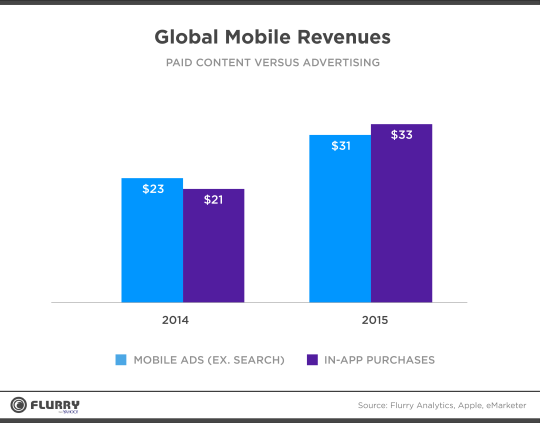Simon Khalaf, SVP, Product & Engineering, Publisher Products
On the 3rd of September, 2015, Benedict Evans, a veteran mobile industry analyst turned venture capitalist, tweeted a chart showing how traditional TV is losing its share of screen to smartphones and tablets. While Mr. Evans’ chart was not the first chart to alarm the cable industry, its timing was particularly interesting, as it came exactly a week before Apple’s major update of its Apple TV hardware. In fact, many financial and industry analysts have predicted the demise of the cable industry since rumors of a new Apple TV hardware or an Apple over-the-top streaming service emerged earlier this year.
After yesterday’s announcement, it turns out fears surrounding the long-term prospects of the cable industry were well warranted. We believe that the industry is facing a perfect storm: Apps, App Stores and Apple.
Apps Are Gaining Ground
After putting the desktop web in their rear view mirror, apps now reign supreme as the top media channel in the United States, even without the help of the mobile browser. For the first time ever, time spent inside mobile applications by the average US consumer has exceeded that of TV.

And they are paying handsomely. This year, it’s estimated that revenues from in-app purchases will exceed advertising revenues for the first time. In 2014, App stores generated $21B USD in sales on a worldwide basis, while the mobile ads industry generated $23B USD during the same time. This year, we expect in-app purchases to exceed $33B USD and the ads industry (excluding search) is expected to generate $31B USD.
As shown on the chart above, the average US consumer is spending 198 minutes per day inside apps compared to 168 minutes on TV. Please note that the 198 minutes per day spent inside apps on smartphones and tablets don’t include time spent in the mobile browser. In fact, if we add that time, the total time spent on mobile devices by the average US consumer is now 220 minutes (or 3 hours and 40 minutes) per day, as we shared a couple of weeks ago.
It is hard for us to quantify how much of that time spent in apps overlaps with time spent on TV, as the second screen phenomena is clearly prevalent especially among generations Y and Z. So, while time-spent on TV hasn’t decreased, it is hard to say how much of that time is actual watching, versus having background noise to the plethora of apps being actively consumed on mobile devices. In the media industry, time-spent is the ultimate metric and if we simply look at the chart above, there is no point for analysts to debate the long term prospects of the cable industry.They’re better off debating its short-term prospects.
App Users Pay For Content
Since its launch in 2008 and until this year, the Apple App Store and its Android counterpart’s top grossing charts have been dominated by the gaming industry. But this year, many media & entertainment apps such as Netflix, Hulu, HBO Now, Spotify and Pandora have ranked well in the top grossing charts and have ended the gaming industry’s de-facto monopoly on the App Store’s revenues. This demonstrates that the mobile consumer has been trained to pay for content.

This impressive growth in sales can easily encourage traditional media companies to move its content to apps and stream it over-the-top, charge consumers for it through the App Stores, and still make money from ads. Most of these companies have been reluctant to do so, out of fear that their content needs to be free and ad-supported when streamed, something they are simply not comfortable with.
If the content continues to move to apps and streamed over the wire, the cable industry will simply be squeezed and will lose its exclusive position as the sole distribution channel between media companies and US consumers.
Here Comes the … New and Improved Apple TV
While Apple didn’t announce its much anticipated TV service (the cable killer) yesterday, it sent a warning shot at the cable industry in particular and the the media industry in general. Apple opened up Apple TV to thousands of app developers, through new hardware, a new IOS9-based Operating System it dubbed “tvOS” and new developer tools. These developers will now bring their content to the TV screen and capture more time from the US consumer. Now rather than having dozens of channels to watch, US consumers will have thousands of apps to enjoy on their flat panel TVs ranging from games, to eSport apps, to live entertainment apps, and to whatever these developers will cook up over the next year. And just as they did on the iPhone and iPads, consumers will download these apps and spend plenty of time on them, leaving the dozen or so cable channels lost in a sea of apps. This will give Apple plenty of time to strike better deals with the media companies and marginalize the cable companies.
While Apple’s CEO Tim Cook’s quote “When you experience TV through an app, you realize how much better it can be” made headline yesterday, We had a different one in mind: “Marginalizing the cable industry…there will be tens of thousands of apps for that.”